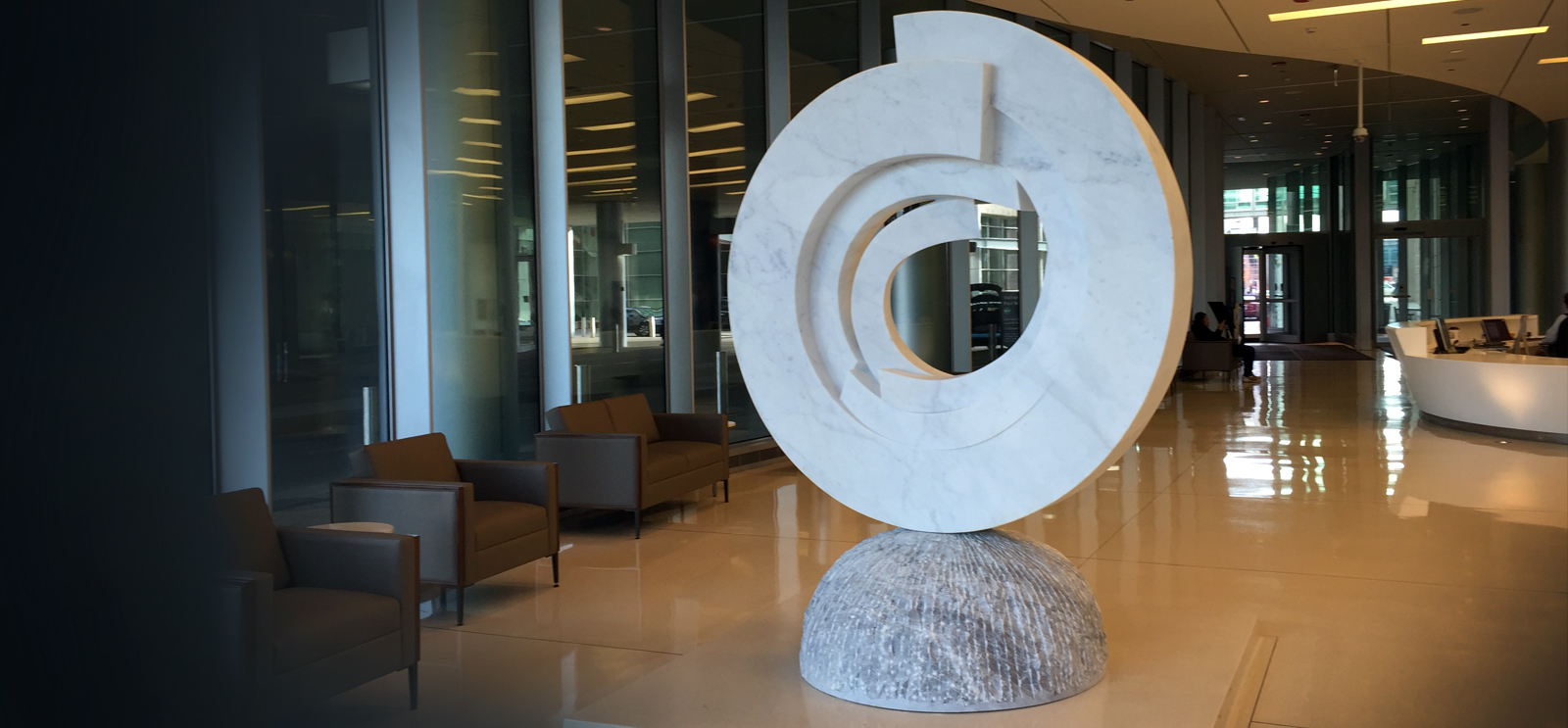
Caring is the sixth Virginio Ferrari sculpture to appear on campus. (Photography by Jeanie Chung)
That’s what sculptor Virginio Ferrari would say, anyway.
“I don’t know if you touched the marble, but it’s like skin,” Virginio Ferrari says of his sculpture Caring in the west lobby of the University of Chicago Medicine’s Center for Care and Discovery. “They don’t let you touch it,” he admits, “but if I was there I would tell you to touch it. Art should be touched.”
Ferrari, who was born in Verona, Italy, was an assistant professor of art and sculptor in residence at the University from 1966 to 1976. But Caring is the result of a friendship dating back even earlier.
During a visit to campus, Ferrari and his wife met Mark Siegler, MD’67, then a medical student, and his wife. The couples met while admiring the Antoine Pevsner sculpture in the Law School’s quadrangle.
Afterward Siegler, now executive director of the Bucksbaum Institute for Clinical Excellence, began collecting Ferrari’s work and was also his doctor. In 2014 Siegler mentioned to Ferrari that Carolyn “Kay” Bucksbaum, who made the gift establishing the institute, was interested in commissioning a sculpture.
Ferrari works primarily in bronze, but for Caring he chose marble. “My father and my grandfather were stonecutters,” he says, “so I grew up with marble. This was a great opportunity to go and choose the marble from the same quarry where Michelangelo, Canova, and Bernini chose their marble. It was a very, very beautiful experience to do that.”
A series of photos on the hospital’s second floor documents the process of choosing the block of Carrara statuary marble, then sculpting and assembling it.
Ferrari describes the concentric circular shapes as representative of the doctor-patient relationship, with the outer circle helping to protect and heal the inner.
“It’s a very dynamic form,” he says. “Those items inside the circle seem like they’re moving: giving life to cure people and giving life to people who are sick. It was like a new life, a new baby.”
In addition to Caring, five other Ferrari sculptures have made their home on campus:
[[{"type":"media","view_mode":"media_original","fid":"3241","attributes":{"alt":"","class":"media-image","height":"648","typeof":"foaf:Image","width":"500"}}]] (Courtesy Virginio Ferrari)
Continuity (1962-92), at the Gordon Center, a gift of the RR Donnelley corporation.
[[{"type":"media","view_mode":"media_original","fid":"3242","attributes":{"alt":"","class":"media-image","height":"458","typeof":"foaf:Image","width":"500"}}]] (Courtesy Virginio Ferrari)
Love and Hope, or Messagio di Speranza (1963-66), originally in the lobby of the Wyler Children’s Hospital.
[[{"type":"media","view_mode":"media_original","fid":"3243","attributes":{"alt":"","class":"media-image","height":"427","typeof":"foaf:Image","width":"500"}}]] (Courtesy Virginio Ferrari)
Interlocking (1993), at the Laboratory Schools.
[[{"type":"media","view_mode":"media_original","fid":"3244","attributes":{"alt":"","class":"media-image","height":"462","typeof":"foaf:Image","width":"500"}}]] (Courtesy Virginio Ferrari)
A bust of Charles B. Huggins (1972–73) at the Ben May Department for Cancer Research.
[[{"type":"media","view_mode":"media_original","fid":"3245","attributes":{"alt":"","class":"media-image","height":"301","typeof":"foaf:Image","width":"500"}}]] (Illustration by Sander Wood Engraving Company, courtesy University of Chicago Magazine archives)
And, of course, Dialogo (1971).
Interlocking and Dialogo are both outdoor sculptures that invite the tactile experience Ferarri would prefer. He’s seen children skate on Dialogo and young people sit on it. “The idea is not a monument, but a dialogue,” he says. “You can be part of that.”
